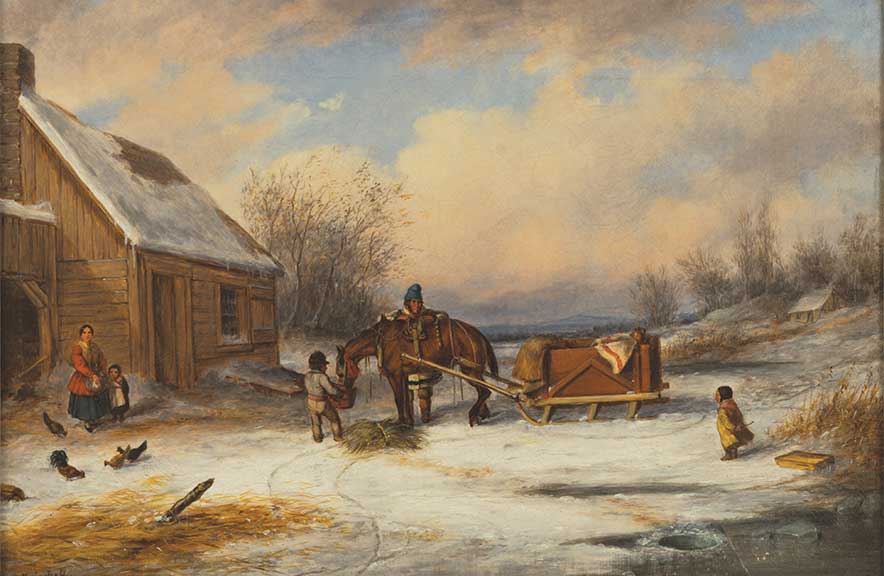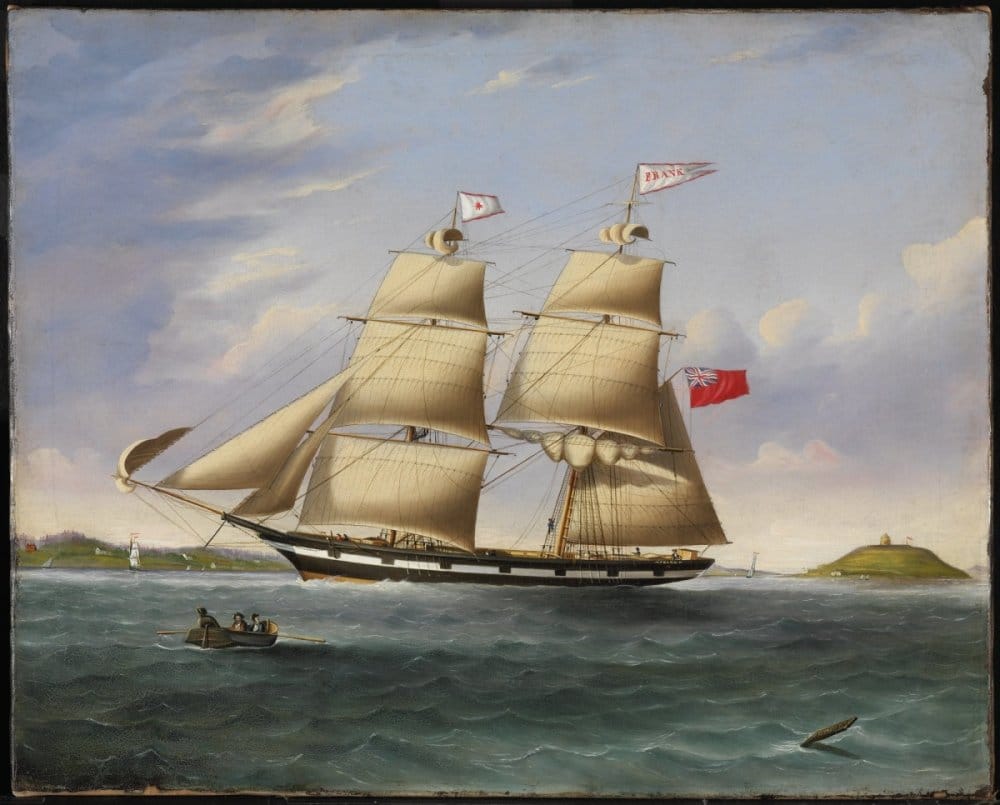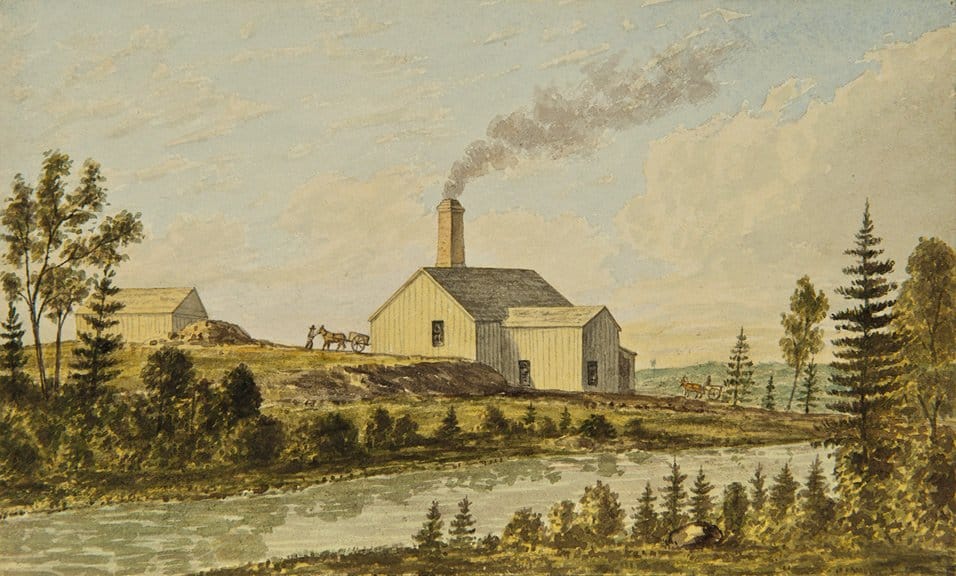After a brief introduction to the history of collecting in Western art, it now seems worthwhile to take a closer look at a singular collector.[i] In this case, it’s an opportunity to honour an entire family of collectors, in line with current museum events. The Musée national des beaux-arts de Québec is currently showcasing one of the most remarkable private collections of Canadian art, that of the Sobey family. Who are the Sobeys and what makes their collection so remarkable? These are the two questions that this document will try to answer.
An entrepreneurial success story, locally and nationally

The Sobeys are well known in the business world. Their story is similar to that of other entrepreneurs of the last century who contributed to Canada’s economic development. It all began with the modest Nova Scotia business of John William Sobey (1869-1949). John William’s father, William (1833-1910), was a member of the British Royal Engineers based in Halifax when he met Janet MacIntosh (1837-1910), a native of Pictou County. After a spell in England, where John Williams was born, Sergeant William was posted to Bermuda; the family, now with six children, returned to settle near Janet’s homeland in Lyons Brook in 1876.[ii] In the early twentieth century, John William married Eliza Creighton (1871-1960), a local schoolteacher whose family, like his mother-in-law’s, was originally from Scotland. The couple settled in Stellarton, a town in the Pictou coalfield, and John William developed his own business buying cattle from local farmers, selling them and delivering them as ready-to-eat meat to his customers.
The adventure continued and took root with the following generations. In 1912, John William’s business was established in Stellarton. In 1924, John William and Eliza’s son, Frank Hoyse Sobey (1902-1985), convinced his father to diversify his business even further, offering a variety of local produce for sale, from market gardening, dairy farming and fishing to everyday foodstuffs and more exotic items. After just fifteen years, the business was already expanding: there are now six shops in Pictou County and the surrounding area. Frank’s entrepreneurial flair led him to took advantage of the post-war growth to open the first “Sobey’s groceteria”, a modern-looking supermarket. Frank and his wife Irene (1904-1983) MacDonald’s three sons, William Macdonald ‘Bill’ (1927-1989), David (1931-2023) and Donald Creighton Rae (1934-2021), gradually joined the family business. In 1971, Frank retired from the business to hand over the reins of Empire Company Limited to the next generation. Supermarkets opened in Ontario in the 1980s. In 1989, Donald and Beth Sobey’s son Rob joined the company. By the turn of the twenty-first century, Empire has become a publicly traded company – since 1959 – and has expanded nationwide through a series of takeovers, with sales in the trillions of dollars and a portfolio of more than 1,500 shops across Canada.[iii]
A passion for art handed down from generation to generation
The third generation of Sobeys to settle in Canada, Frank and Irene, have developed a passion for collecting art. Their interest was primarily in Canadian art, from its beginnings in the nineteenth century to current artistic novelties. This passion was passed on to their son Donald, whose acquisitions have continued to enrich the family collection. Donald was also behind the creation of the Sobey Art Award in 2002. This prestigious award is presented annually to an emerging contemporary artist. It is now Donald and Beth Sobey’s son Rob who oversees the family’s philanthropic commitment to the Canadian arts. Like their company, the Sobeys’ collections now include works from across Canada, following the broad chronological spectrum begun in the early days of the original collection.

Many of the works acquired by the art-loving couple Frank and Irene are now in the collections of succeeding generations. However, a significant part of their original collection is usually preserved and exhibited at the Sobey Art Foundation at Crombie House, their former home in Abercrombie, Nova Scotia. The exhibition ‘Generations, the Sobey Family and Canadian Art’ brings together works from these sources – family collections and Crombie House – and others involving works donated by the family to public institutions. It is being presented in Quebec City, after having been shown in Kleinburg (Ontario), St. John’s (Newfoundland), Edmonton (Alberta), Charlottetown (Prince Edward Island) and Halifax (Nova Scotia).
A taste for Canadian painting
The Sobeys acquired works by some old masters of landscape. Their collections include several paintings by Cornelius Krieghoff (1815-1872).

Krieghoff’s life began in Amsterdam and spanned two continents. After an introduction to music and painting in his own family, the young Krieghoff left for Germany, where he acquired his artistic training. He seems to have travelled over Europe before leaving for New York, where he served in the American army as an artist from 1837 to 1840. With his French-Canadian wife, whom he had met in New York, he settled in Montreal, after first passing through Toronto, and then Quebec City in 1854. The painter specialised in genre scenes and local scenery; he quickly became the painter of everyday life in Canada. He probably returned to Europe after some twenty-five years on the North American continent, coming back again in Canada in 1872, the year of his death.[iv]

The Sobeys were probably interested in Krieghoff as an early master of the Canadian landscape; the approach is similar for other masters of the native landscape. Of Irish descent, John O’Brien (1831-1891) grew up in Halifax, where he trained as a self-taught sign painter and ships’ portraitist by copying masters. Thanks to the support of local patrons, O’Brien was able to train in Europe in 1857, in particular with the London marine painter John Wilson Carmichael (1800-1868). On his return to Halifax, he worked as a marine painter. He also assisted the photographer Wellington Chase, one of the first on this side of the Atlantic to produce daguerreotypes, the forerunner of photography developed in France in 1839.[v]

The watercolours by Frederick B. Nichols (1824- c.1906) are an exception in the Sobey collections, which are more interested in oils on canvas. Nichols, an American from Connecticut, was one of the first non-Aboriginal artists to paint Nova Scotia landscapes.[vi] His watercolours, along with O’Brien’s seascapes and Krieghoff’s genre scenes, reflect the attachment of the young country’s first artists to European pictorial traditions, particularly British and Dutch.
The Sobeys collections include many works from two key periods in Canadian landscape art: that of the Impressionist painters and that of the Group of Seven. Mainly from Quebec, the Canadian Impressionists followed in the footsteps of their French predecessors, including in the literal sense of the word from a geographical point of view, while adapting the aesthetics of their works and their technique to the specificity of the Canadian landscape. The Sobey collections include works by Maurice Cullen (1866-1934), Clarence Gagnon (1881-1942), James Wilson Morrice (1865-1924) and Marc-Aurèle de Foy Suzor-Côté (1869-1937). With an aesthetic partly rooted in Impressionism, the works of the Group of Seven landscapists celebrated the splendour of rustic landscapes across Canada, especially those of the Rockies, Ontario’s lakes and the Maritimes.[vii] These painters of the same generation (born in the 1880s), on the threshold of a new century when they began their careers, were anchored in the city of Toronto, where their sociability revolved around debates on the specificities of a national art form.[viii] Through their work, they have explored the ‘modernity’ of Canadian landscape. The Group also gravitated around other contemporary landscape artists: shared resonances can be observed in their figurations. Testifying to this, landscapes by Emily Carr (1871-1945), Thomas John Thomson (1877-1917) and Alfred Joseph Casson (1898-1992) are also part of the Sobey family collection.
Finally, the Sobey collections have always included works by contemporary artists. These include oil paintings by Quebec painters Paul-Émile Borduas (1905-1960), Jean-Paul Lemieux (1904-1990) and Jean Paul Riopelle (1923-2002), and works by Ukrainian-Canadian artist William Kurelek (1927-1977), all of whom belong to Frank and Irene’s generation. Similarly, Mario Doucette (b. 1971) and Joseph Tisiga (b. 1984), an Aboriginal artist on a par with Kent Monkman (b. 1965) and Annie Pootoogook (1969-2016), are all artists who are contemporaries of the Sobey sons and grandsons.
Conclusion
Two pictorial genres reign supreme in the Sobey collections: landscape and genre scenes. They are somehow representative of the evolution of Canadian art from its origins to the present day. Some contemporary works echo those of the old masters. The composition of the Sobey collections is of singular interest because, as Jocelyn Anderson points out, it raises the question of how to define Canadian art, a question that is constantly being raised, and which is itself woven into the exploration of its foundations.[ix]
[i] See the article “Collecting art: a constantly renewed passion” in this same blog – October 2023.
[ii] William and Janet had a total of ten children, the last of whom was born in 1883.
[iii] Historical data and figures were taken from information provided by the websites fondationsobeypourlesarts.com/corporate.sobeys.com and https://www.sobeys110.com/fr/chronologie/.
[iv] In the absence of documents, this departure for Europe cannot be confirmed. Krieghoff’s departure to Europe was advertised in the Journal de Québec of 1 August 1867, but according to Raymond Vézina, Krieghoff went instead to join his daughter in Chicago. See Raymond Vézina, “Krieghoff, Cornelius” in Dictionary of Canadian Biography, vol. 10, Université Laval/University of Toronto, 2003-. http://www.biographi.ca/fr/bio/krieghoff_cornelius_10F.html. The biographical information on Krieghoff is taken from this article and the monograph by the same author, Cornelius Krieghoff, peintre de mœurs, 1815-1872 (Ottawa: Éditions du Pélican, 1972).
[v] On John O’Brien, see Ray Cronin, “John O”Brien (1831-1891) in Halifax Art and Artists. An Illustrated History, 2023, Canadian Art Institute online https://www.aci-iac.ca/fr/livres-dart/art-et-artistes-de-halifax/artistes-phares/john-obrien/
[vi] On Nichols, see Mora Dianne O’Neill, Paintings of Nova Scotia : from the collection of the Art Gallery of Nova Scotia (Halifax: Nimbus Pub., 2004).
[vii] See John Geoghegan, “Making the French Connection: The Group of Seven and Quebec Painting” in Sarah Milroy (ed.), Generations The Sobey family & Canadian Art, exh. cat. Kleinburg, The McMichael Canadian Art Collection, St. John’s, The Rooms, Edmonton, Art Gallery of Alberta, Charlottetown, Confederation Centre of the Arts, Halifax, Art Gallery of Nova Scotia, Québec, Musée national des beaux-arts du Québec, 2022-2024 (Kleinburg, Fredericton: The McMichael Canadian Art Collection/Goose Lane Editions, 2022), p. 151-165.
[viii] The following painters belong to the Group of Seven: Franklin Carmichael (1890-1945), Lawrence Harris (1885-1970), A.Y. Jackson (1882-1974), Frank Johnston (1888-1949), Arthur Lismer (1885-1969), J.E.H. MacDonald (1873-1932), F.H. ‘Fred’ Varley (1881-1969). The Group was officially formed to prepare a joint exhibition in 1920; however, links between painters and a shared artistic practice had already existed since the turn of the century. For an introduction to the members and works of the Group of Seven, see, among others, Peter Mellen, Le Group des Sept (La Prairie: M. Broquet, 1980); Anne Newlands, The Group of Seven and Tom Thomson (Richmond Hill: Firefly Books, 2017 (1st ed. 1997)).
[ix] Jocelyn Anderson, “Patriotic and Artistic: Canadian Painters and the National Challenge” in Kleinburg, St. John’s, Edmonton, Charlottetown, Halifax, Québec, 2022, p. 45-57.